Business Planning: Budgeted and Actual Statement of Profit and Loss, Financial Position, Costs, Line Graphs and Performance Ratios
VerifiedAdded on 2023/06/18
|14
|2861
|303
AI Summary
This report prepares a budgeted and actual income statement and balance sheet for the firm along with making analysis of the variations taken place and the reason behind it. It also includes depiction of various costs of the business on pie chart format, line graphs for representing the budgeted performance of the company with that of the actual position and calculation of performance ratios.
Contribute Materials
Your contribution can guide someone’s learning journey. Share your
documents today.
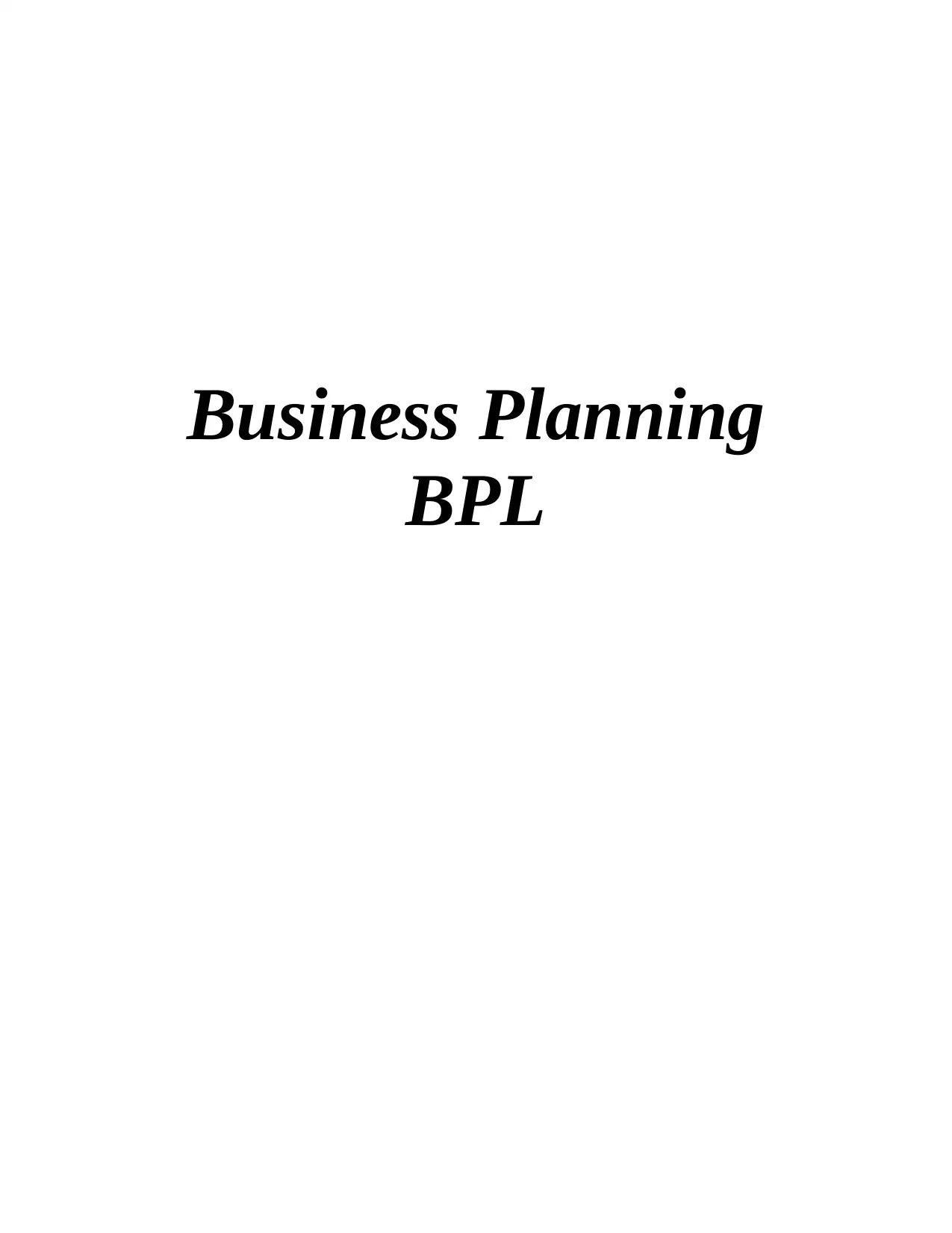
Business Planning
BPL
BPL
Secure Best Marks with AI Grader
Need help grading? Try our AI Grader for instant feedback on your assignments.
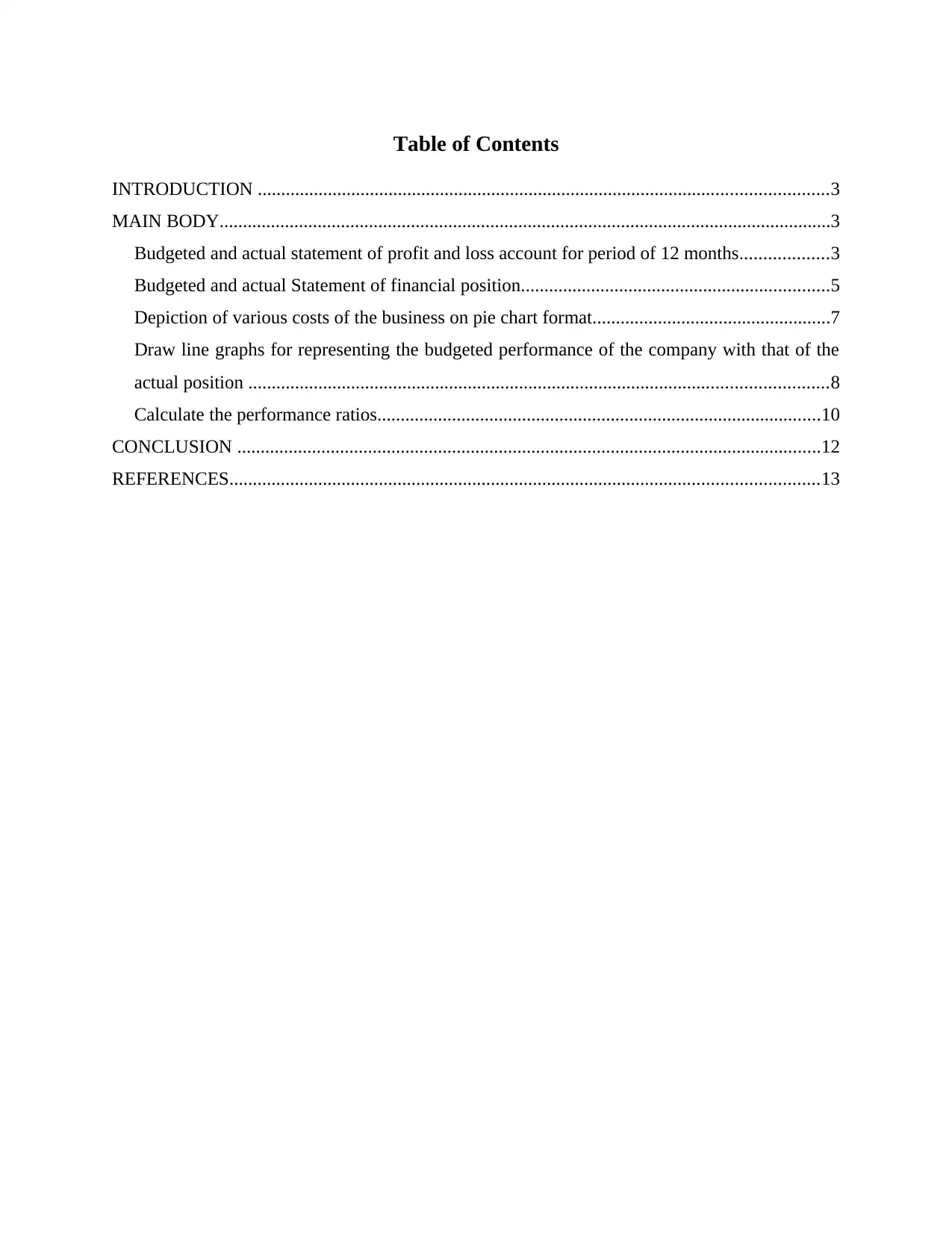
Table of Contents
INTRODUCTION ..........................................................................................................................3
MAIN BODY...................................................................................................................................3
Budgeted and actual statement of profit and loss account for period of 12 months...................3
Budgeted and actual Statement of financial position..................................................................5
Depiction of various costs of the business on pie chart format...................................................7
Draw line graphs for representing the budgeted performance of the company with that of the
actual position ............................................................................................................................8
Calculate the performance ratios...............................................................................................10
CONCLUSION .............................................................................................................................12
REFERENCES..............................................................................................................................13
INTRODUCTION ..........................................................................................................................3
MAIN BODY...................................................................................................................................3
Budgeted and actual statement of profit and loss account for period of 12 months...................3
Budgeted and actual Statement of financial position..................................................................5
Depiction of various costs of the business on pie chart format...................................................7
Draw line graphs for representing the budgeted performance of the company with that of the
actual position ............................................................................................................................8
Calculate the performance ratios...............................................................................................10
CONCLUSION .............................................................................................................................12
REFERENCES..............................................................................................................................13
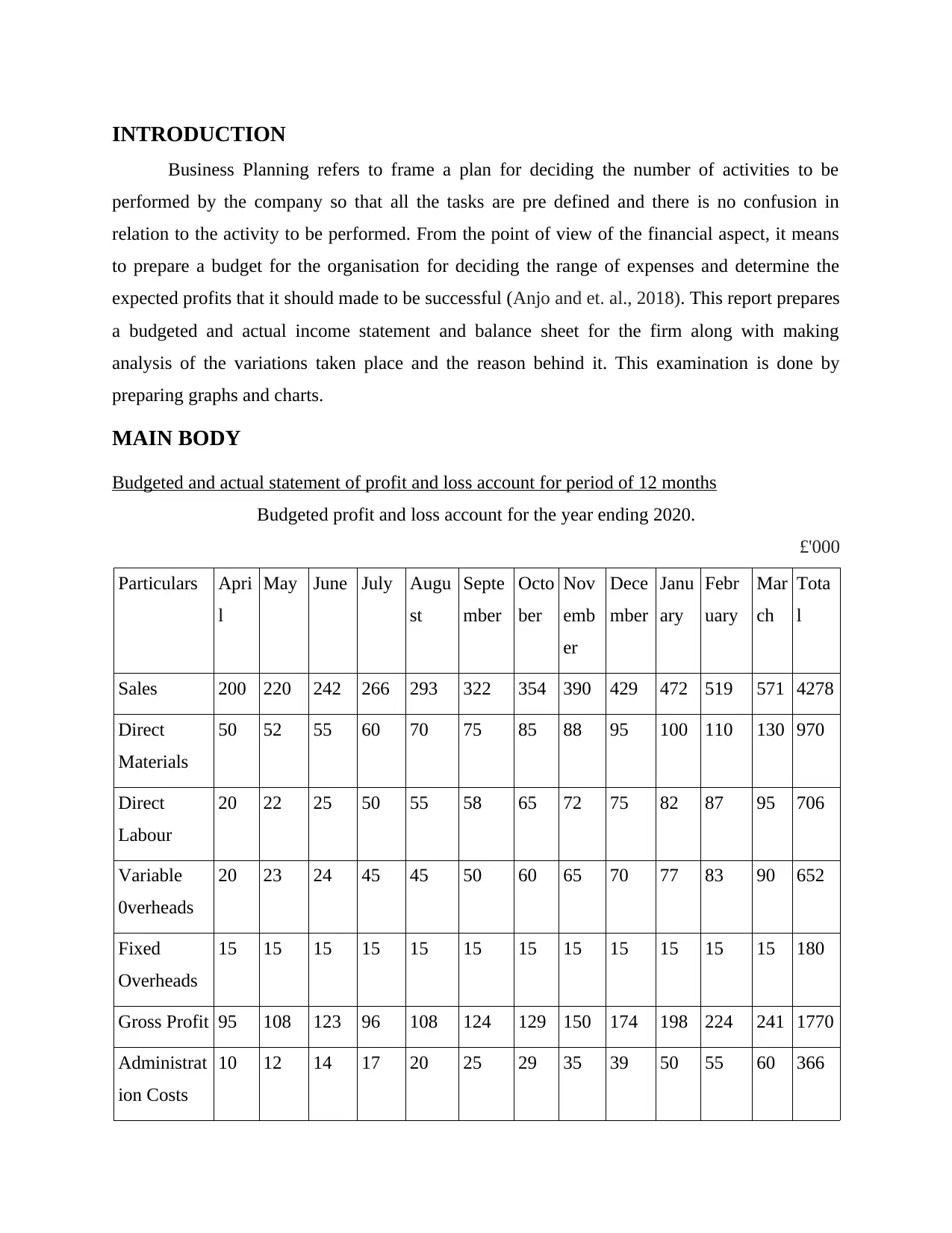
INTRODUCTION
Business Planning refers to frame a plan for deciding the number of activities to be
performed by the company so that all the tasks are pre defined and there is no confusion in
relation to the activity to be performed. From the point of view of the financial aspect, it means
to prepare a budget for the organisation for deciding the range of expenses and determine the
expected profits that it should made to be successful (Anjo and et. al., 2018). This report prepares
a budgeted and actual income statement and balance sheet for the firm along with making
analysis of the variations taken place and the reason behind it. This examination is done by
preparing graphs and charts.
MAIN BODY
Budgeted and actual statement of profit and loss account for period of 12 months
Budgeted profit and loss account for the year ending 2020.
£'000
Particulars Apri
l
May June July Augu
st
Septe
mber
Octo
ber
Nov
emb
er
Dece
mber
Janu
ary
Febr
uary
Mar
ch
Tota
l
Sales 200 220 242 266 293 322 354 390 429 472 519 571 4278
Direct
Materials
50 52 55 60 70 75 85 88 95 100 110 130 970
Direct
Labour
20 22 25 50 55 58 65 72 75 82 87 95 706
Variable
0verheads
20 23 24 45 45 50 60 65 70 77 83 90 652
Fixed
Overheads
15 15 15 15 15 15 15 15 15 15 15 15 180
Gross Profit 95 108 123 96 108 124 129 150 174 198 224 241 1770
Administrat
ion Costs
10 12 14 17 20 25 29 35 39 50 55 60 366
Business Planning refers to frame a plan for deciding the number of activities to be
performed by the company so that all the tasks are pre defined and there is no confusion in
relation to the activity to be performed. From the point of view of the financial aspect, it means
to prepare a budget for the organisation for deciding the range of expenses and determine the
expected profits that it should made to be successful (Anjo and et. al., 2018). This report prepares
a budgeted and actual income statement and balance sheet for the firm along with making
analysis of the variations taken place and the reason behind it. This examination is done by
preparing graphs and charts.
MAIN BODY
Budgeted and actual statement of profit and loss account for period of 12 months
Budgeted profit and loss account for the year ending 2020.
£'000
Particulars Apri
l
May June July Augu
st
Septe
mber
Octo
ber
Nov
emb
er
Dece
mber
Janu
ary
Febr
uary
Mar
ch
Tota
l
Sales 200 220 242 266 293 322 354 390 429 472 519 571 4278
Direct
Materials
50 52 55 60 70 75 85 88 95 100 110 130 970
Direct
Labour
20 22 25 50 55 58 65 72 75 82 87 95 706
Variable
0verheads
20 23 24 45 45 50 60 65 70 77 83 90 652
Fixed
Overheads
15 15 15 15 15 15 15 15 15 15 15 15 180
Gross Profit 95 108 123 96 108 124 129 150 174 198 224 241 1770
Administrat
ion Costs
10 12 14 17 20 25 29 35 39 50 55 60 366
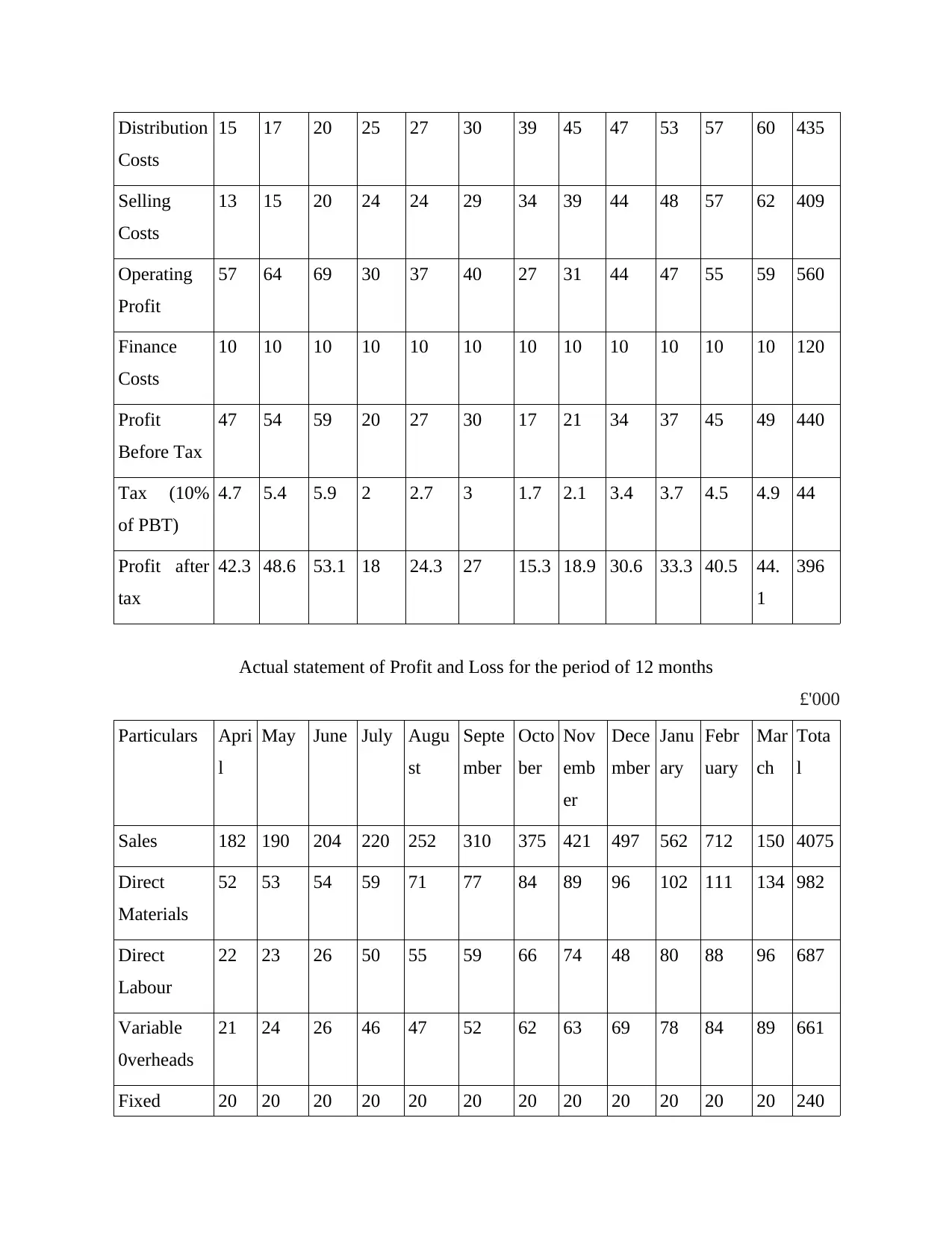
Distribution
Costs
15 17 20 25 27 30 39 45 47 53 57 60 435
Selling
Costs
13 15 20 24 24 29 34 39 44 48 57 62 409
Operating
Profit
57 64 69 30 37 40 27 31 44 47 55 59 560
Finance
Costs
10 10 10 10 10 10 10 10 10 10 10 10 120
Profit
Before Tax
47 54 59 20 27 30 17 21 34 37 45 49 440
Tax (10%
of PBT)
4.7 5.4 5.9 2 2.7 3 1.7 2.1 3.4 3.7 4.5 4.9 44
Profit after
tax
42.3 48.6 53.1 18 24.3 27 15.3 18.9 30.6 33.3 40.5 44.
1
396
Actual statement of Profit and Loss for the period of 12 months
£'000
Particulars Apri
l
May June July Augu
st
Septe
mber
Octo
ber
Nov
emb
er
Dece
mber
Janu
ary
Febr
uary
Mar
ch
Tota
l
Sales 182 190 204 220 252 310 375 421 497 562 712 150 4075
Direct
Materials
52 53 54 59 71 77 84 89 96 102 111 134 982
Direct
Labour
22 23 26 50 55 59 66 74 48 80 88 96 687
Variable
0verheads
21 24 26 46 47 52 62 63 69 78 84 89 661
Fixed 20 20 20 20 20 20 20 20 20 20 20 20 240
Costs
15 17 20 25 27 30 39 45 47 53 57 60 435
Selling
Costs
13 15 20 24 24 29 34 39 44 48 57 62 409
Operating
Profit
57 64 69 30 37 40 27 31 44 47 55 59 560
Finance
Costs
10 10 10 10 10 10 10 10 10 10 10 10 120
Profit
Before Tax
47 54 59 20 27 30 17 21 34 37 45 49 440
Tax (10%
of PBT)
4.7 5.4 5.9 2 2.7 3 1.7 2.1 3.4 3.7 4.5 4.9 44
Profit after
tax
42.3 48.6 53.1 18 24.3 27 15.3 18.9 30.6 33.3 40.5 44.
1
396
Actual statement of Profit and Loss for the period of 12 months
£'000
Particulars Apri
l
May June July Augu
st
Septe
mber
Octo
ber
Nov
emb
er
Dece
mber
Janu
ary
Febr
uary
Mar
ch
Tota
l
Sales 182 190 204 220 252 310 375 421 497 562 712 150 4075
Direct
Materials
52 53 54 59 71 77 84 89 96 102 111 134 982
Direct
Labour
22 23 26 50 55 59 66 74 48 80 88 96 687
Variable
0verheads
21 24 26 46 47 52 62 63 69 78 84 89 661
Fixed 20 20 20 20 20 20 20 20 20 20 20 20 240
Paraphrase This Document
Need a fresh take? Get an instant paraphrase of this document with our AI Paraphraser

Overheads
Gross Profit 67 70 78 45 59 102 143 175 264 282 409 -
189
1505
Administrat
ion Costs
11 13 15 17 21 26 30 36 39 52 57 62 379
Distribution
Costs
16 18 20 27 28 31 39 47 49 54 59 62 450
Selling
Costs
14 16 23 25 26 31 35 39 47 49 59 65 429
Operating
Profits
26 23 20 -24 -16 14 39 53 129 127 234 -
378
247
Finance
Costs
10 10 10 10 10 10 10 10 10 10 10 10 120
Profit
Before Tax
16 13 10 -34 -26 4 29 43 119 117 224 -
388
127
Tax (10%
of PBT)
1.6 1.3 1 -3.4 -2.6 0.4 2.9 4.3 11.9 11.7 22.4 -
38.
8
12.7
Profit after
tax
14.4 11.7 9 -
30.6
-23.4 3.6 26.1 38.7 107.
1
105.
3
201.6 -
349
.2
114.
3
Budgeted and actual Statement of financial position.
Budgeted Financial position
£'000
£' £'
Assets
Gross Profit 67 70 78 45 59 102 143 175 264 282 409 -
189
1505
Administrat
ion Costs
11 13 15 17 21 26 30 36 39 52 57 62 379
Distribution
Costs
16 18 20 27 28 31 39 47 49 54 59 62 450
Selling
Costs
14 16 23 25 26 31 35 39 47 49 59 65 429
Operating
Profits
26 23 20 -24 -16 14 39 53 129 127 234 -
378
247
Finance
Costs
10 10 10 10 10 10 10 10 10 10 10 10 120
Profit
Before Tax
16 13 10 -34 -26 4 29 43 119 117 224 -
388
127
Tax (10%
of PBT)
1.6 1.3 1 -3.4 -2.6 0.4 2.9 4.3 11.9 11.7 22.4 -
38.
8
12.7
Profit after
tax
14.4 11.7 9 -
30.6
-23.4 3.6 26.1 38.7 107.
1
105.
3
201.6 -
349
.2
114.
3
Budgeted and actual Statement of financial position.
Budgeted Financial position
£'000
£' £'
Assets
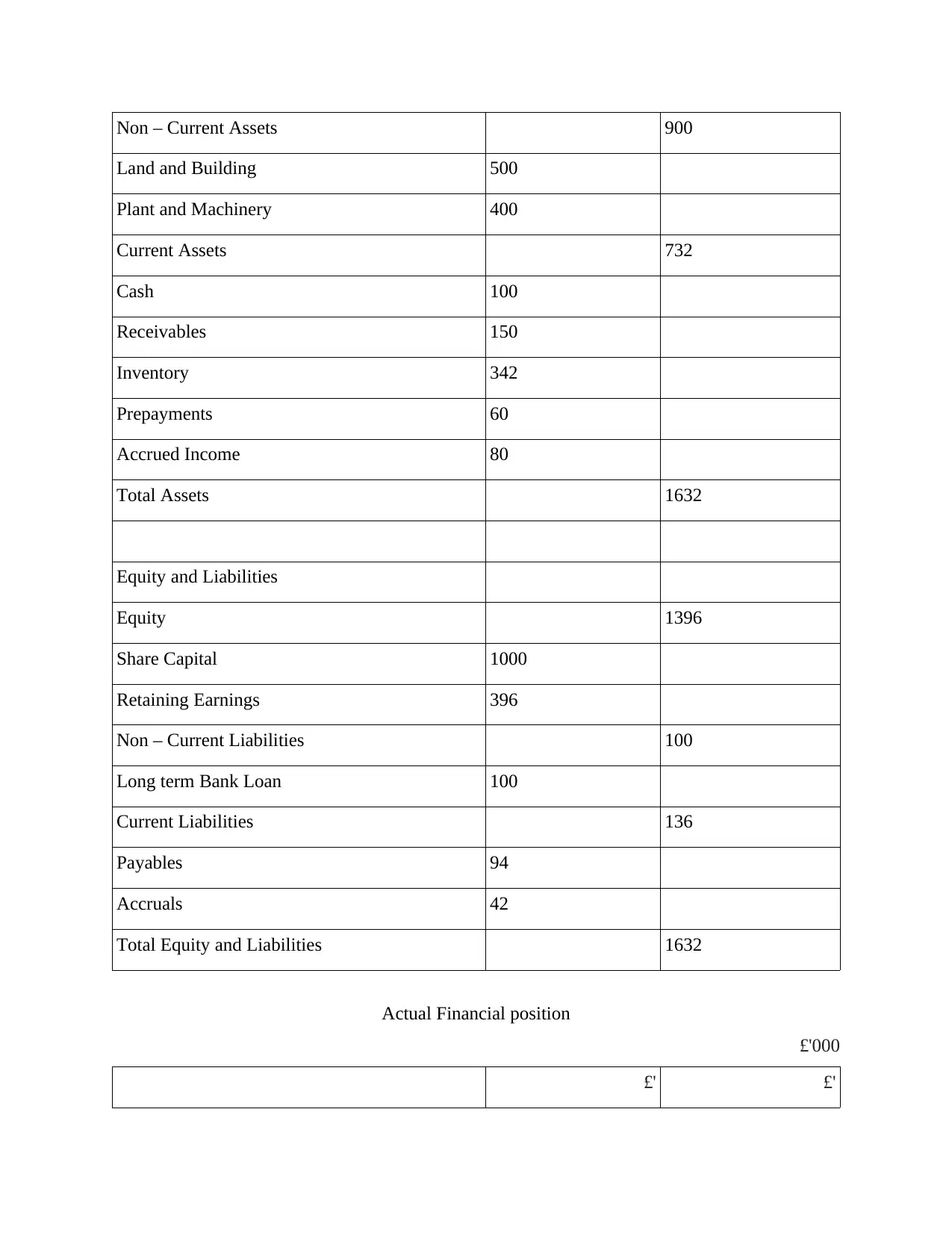
Non – Current Assets 900
Land and Building 500
Plant and Machinery 400
Current Assets 732
Cash 100
Receivables 150
Inventory 342
Prepayments 60
Accrued Income 80
Total Assets 1632
Equity and Liabilities
Equity 1396
Share Capital 1000
Retaining Earnings 396
Non – Current Liabilities 100
Long term Bank Loan 100
Current Liabilities 136
Payables 94
Accruals 42
Total Equity and Liabilities 1632
Actual Financial position
£'000
£' £'
Land and Building 500
Plant and Machinery 400
Current Assets 732
Cash 100
Receivables 150
Inventory 342
Prepayments 60
Accrued Income 80
Total Assets 1632
Equity and Liabilities
Equity 1396
Share Capital 1000
Retaining Earnings 396
Non – Current Liabilities 100
Long term Bank Loan 100
Current Liabilities 136
Payables 94
Accruals 42
Total Equity and Liabilities 1632
Actual Financial position
£'000
£' £'
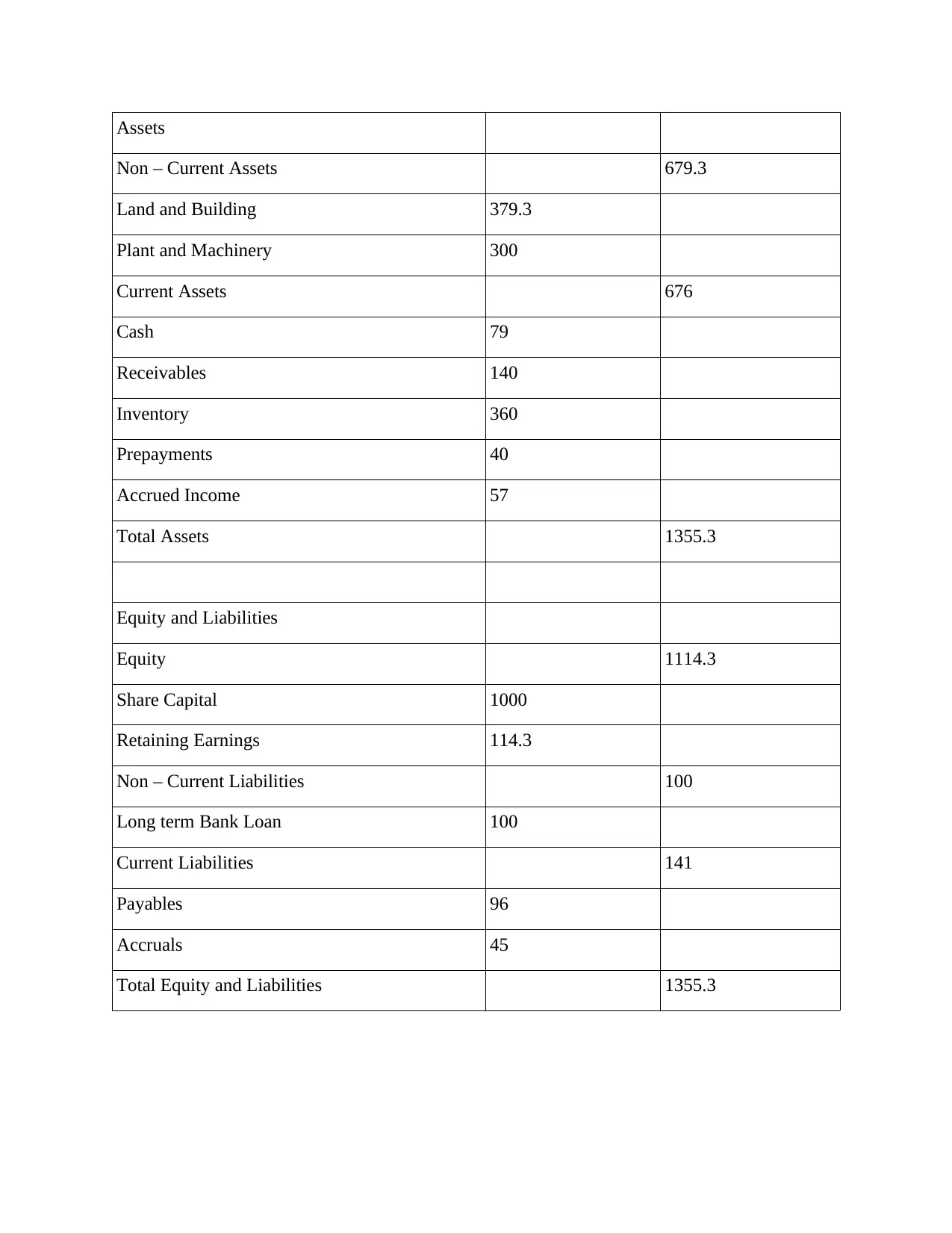
Assets
Non – Current Assets 679.3
Land and Building 379.3
Plant and Machinery 300
Current Assets 676
Cash 79
Receivables 140
Inventory 360
Prepayments 40
Accrued Income 57
Total Assets 1355.3
Equity and Liabilities
Equity 1114.3
Share Capital 1000
Retaining Earnings 114.3
Non – Current Liabilities 100
Long term Bank Loan 100
Current Liabilities 141
Payables 96
Accruals 45
Total Equity and Liabilities 1355.3
Non – Current Assets 679.3
Land and Building 379.3
Plant and Machinery 300
Current Assets 676
Cash 79
Receivables 140
Inventory 360
Prepayments 40
Accrued Income 57
Total Assets 1355.3
Equity and Liabilities
Equity 1114.3
Share Capital 1000
Retaining Earnings 114.3
Non – Current Liabilities 100
Long term Bank Loan 100
Current Liabilities 141
Payables 96
Accruals 45
Total Equity and Liabilities 1355.3
Secure Best Marks with AI Grader
Need help grading? Try our AI Grader for instant feedback on your assignments.
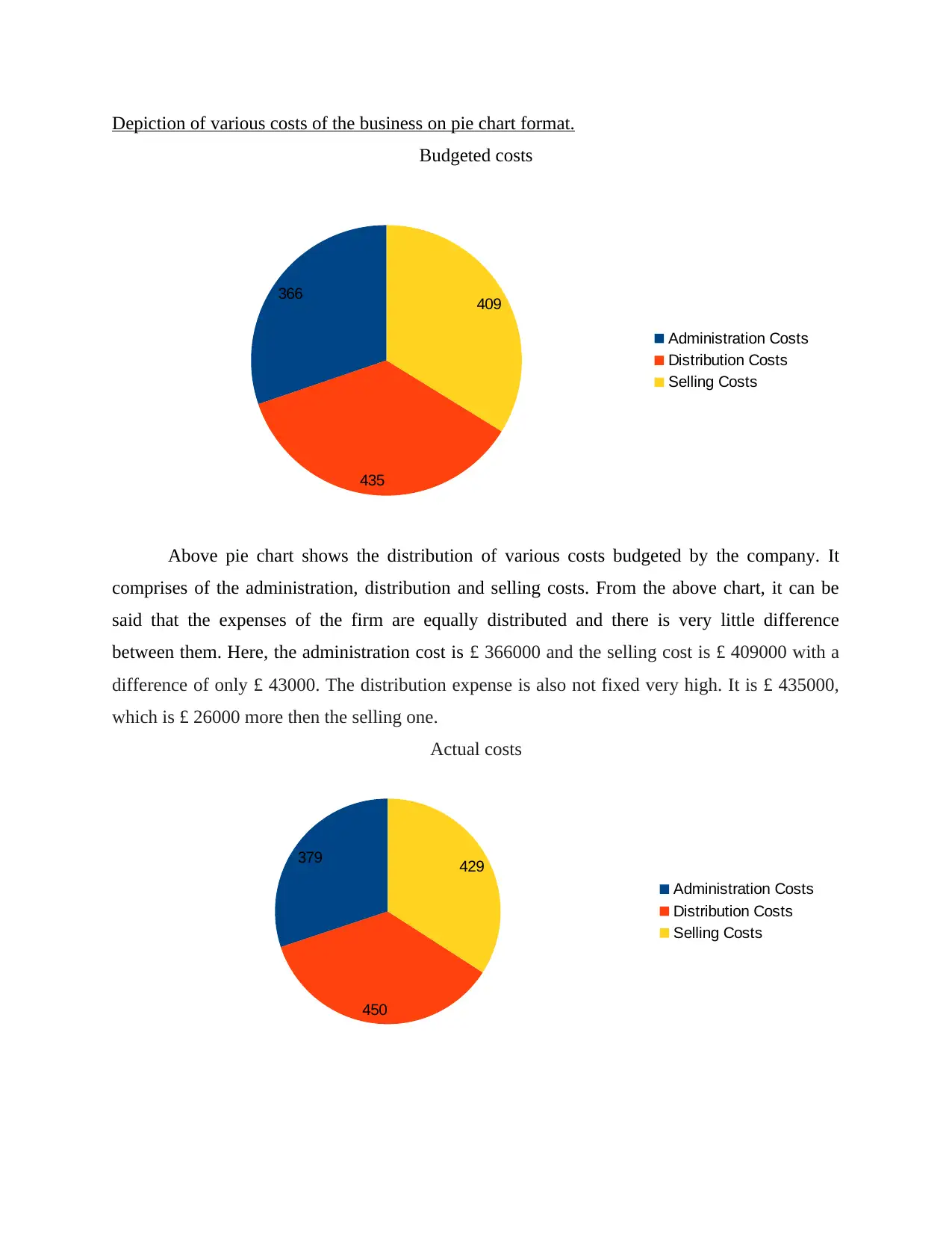
Depiction of various costs of the business on pie chart format.
Budgeted costs
Above pie chart shows the distribution of various costs budgeted by the company. It
comprises of the administration, distribution and selling costs. From the above chart, it can be
said that the expenses of the firm are equally distributed and there is very little difference
between them. Here, the administration cost is £ 366000 and the selling cost is £ 409000 with a
difference of only £ 43000. The distribution expense is also not fixed very high. It is £ 435000,
which is £ 26000 more then the selling one.
Actual costs
366
435
409
Administration Costs
Distribution Costs
Selling Costs
379
450
429
Administration Costs
Distribution Costs
Selling Costs
Budgeted costs
Above pie chart shows the distribution of various costs budgeted by the company. It
comprises of the administration, distribution and selling costs. From the above chart, it can be
said that the expenses of the firm are equally distributed and there is very little difference
between them. Here, the administration cost is £ 366000 and the selling cost is £ 409000 with a
difference of only £ 43000. The distribution expense is also not fixed very high. It is £ 435000,
which is £ 26000 more then the selling one.
Actual costs
366
435
409
Administration Costs
Distribution Costs
Selling Costs
379
450
429
Administration Costs
Distribution Costs
Selling Costs
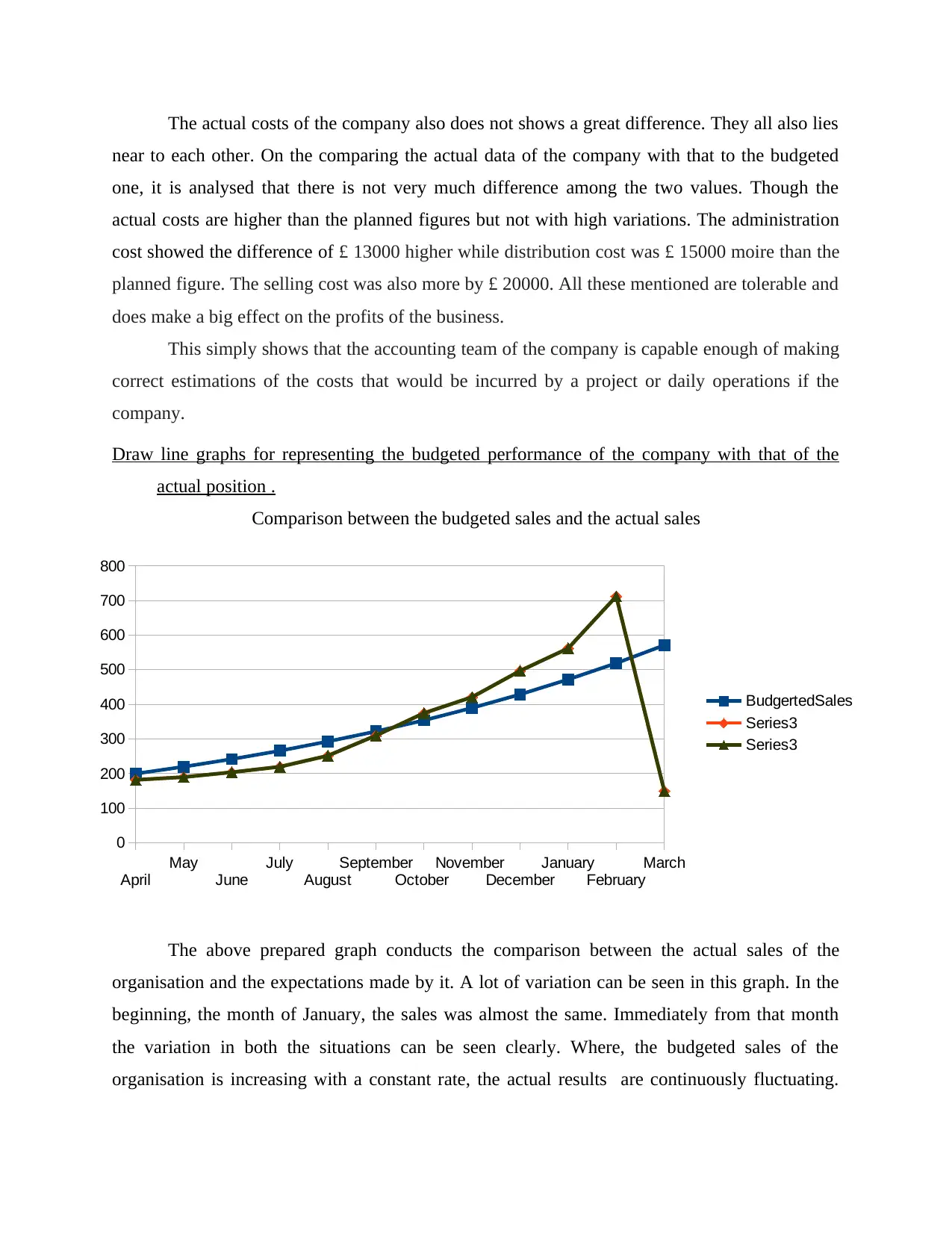
The actual costs of the company also does not shows a great difference. They all also lies
near to each other. On the comparing the actual data of the company with that to the budgeted
one, it is analysed that there is not very much difference among the two values. Though the
actual costs are higher than the planned figures but not with high variations. The administration
cost showed the difference of £ 13000 higher while distribution cost was £ 15000 moire than the
planned figure. The selling cost was also more by £ 20000. All these mentioned are tolerable and
does make a big effect on the profits of the business.
This simply shows that the accounting team of the company is capable enough of making
correct estimations of the costs that would be incurred by a project or daily operations if the
company.
Draw line graphs for representing the budgeted performance of the company with that of the
actual position .
Comparison between the budgeted sales and the actual sales
The above prepared graph conducts the comparison between the actual sales of the
organisation and the expectations made by it. A lot of variation can be seen in this graph. In the
beginning, the month of January, the sales was almost the same. Immediately from that month
the variation in both the situations can be seen clearly. Where, the budgeted sales of the
organisation is increasing with a constant rate, the actual results are continuously fluctuating.
April
May
June
July
August
September
October
November
December
January
February
March
0
100
200
300
400
500
600
700
800
BudgertedSales
Series3
Series3
near to each other. On the comparing the actual data of the company with that to the budgeted
one, it is analysed that there is not very much difference among the two values. Though the
actual costs are higher than the planned figures but not with high variations. The administration
cost showed the difference of £ 13000 higher while distribution cost was £ 15000 moire than the
planned figure. The selling cost was also more by £ 20000. All these mentioned are tolerable and
does make a big effect on the profits of the business.
This simply shows that the accounting team of the company is capable enough of making
correct estimations of the costs that would be incurred by a project or daily operations if the
company.
Draw line graphs for representing the budgeted performance of the company with that of the
actual position .
Comparison between the budgeted sales and the actual sales
The above prepared graph conducts the comparison between the actual sales of the
organisation and the expectations made by it. A lot of variation can be seen in this graph. In the
beginning, the month of January, the sales was almost the same. Immediately from that month
the variation in both the situations can be seen clearly. Where, the budgeted sales of the
organisation is increasing with a constant rate, the actual results are continuously fluctuating.
April
May
June
July
August
September
October
November
December
January
February
March
0
100
200
300
400
500
600
700
800
BudgertedSales
Series3
Series3
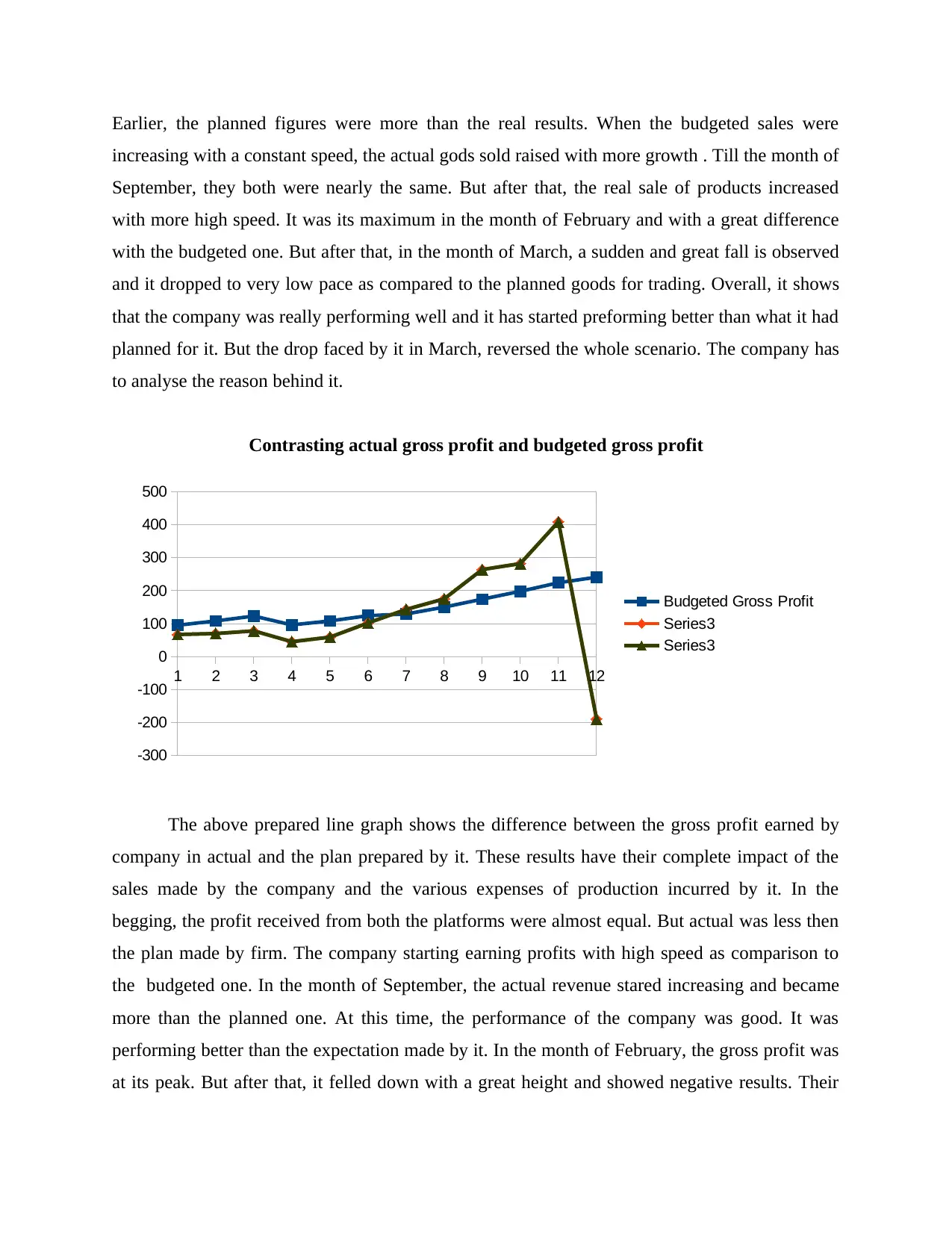
Earlier, the planned figures were more than the real results. When the budgeted sales were
increasing with a constant speed, the actual gods sold raised with more growth . Till the month of
September, they both were nearly the same. But after that, the real sale of products increased
with more high speed. It was its maximum in the month of February and with a great difference
with the budgeted one. But after that, in the month of March, a sudden and great fall is observed
and it dropped to very low pace as compared to the planned goods for trading. Overall, it shows
that the company was really performing well and it has started preforming better than what it had
planned for it. But the drop faced by it in March, reversed the whole scenario. The company has
to analyse the reason behind it.
Contrasting actual gross profit and budgeted gross profit
The above prepared line graph shows the difference between the gross profit earned by
company in actual and the plan prepared by it. These results have their complete impact of the
sales made by the company and the various expenses of production incurred by it. In the
begging, the profit received from both the platforms were almost equal. But actual was less then
the plan made by firm. The company starting earning profits with high speed as comparison to
the budgeted one. In the month of September, the actual revenue stared increasing and became
more than the planned one. At this time, the performance of the company was good. It was
performing better than the expectation made by it. In the month of February, the gross profit was
at its peak. But after that, it felled down with a great height and showed negative results. Their
1 2 3 4 5 6 7 8 9 10 11 12
-300
-200
-100
0
100
200
300
400
500
Budgeted Gross Profit
Series3
Series3
increasing with a constant speed, the actual gods sold raised with more growth . Till the month of
September, they both were nearly the same. But after that, the real sale of products increased
with more high speed. It was its maximum in the month of February and with a great difference
with the budgeted one. But after that, in the month of March, a sudden and great fall is observed
and it dropped to very low pace as compared to the planned goods for trading. Overall, it shows
that the company was really performing well and it has started preforming better than what it had
planned for it. But the drop faced by it in March, reversed the whole scenario. The company has
to analyse the reason behind it.
Contrasting actual gross profit and budgeted gross profit
The above prepared line graph shows the difference between the gross profit earned by
company in actual and the plan prepared by it. These results have their complete impact of the
sales made by the company and the various expenses of production incurred by it. In the
begging, the profit received from both the platforms were almost equal. But actual was less then
the plan made by firm. The company starting earning profits with high speed as comparison to
the budgeted one. In the month of September, the actual revenue stared increasing and became
more than the planned one. At this time, the performance of the company was good. It was
performing better than the expectation made by it. In the month of February, the gross profit was
at its peak. But after that, it felled down with a great height and showed negative results. Their
1 2 3 4 5 6 7 8 9 10 11 12
-300
-200
-100
0
100
200
300
400
500
Budgeted Gross Profit
Series3
Series3
Paraphrase This Document
Need a fresh take? Get an instant paraphrase of this document with our AI Paraphraser
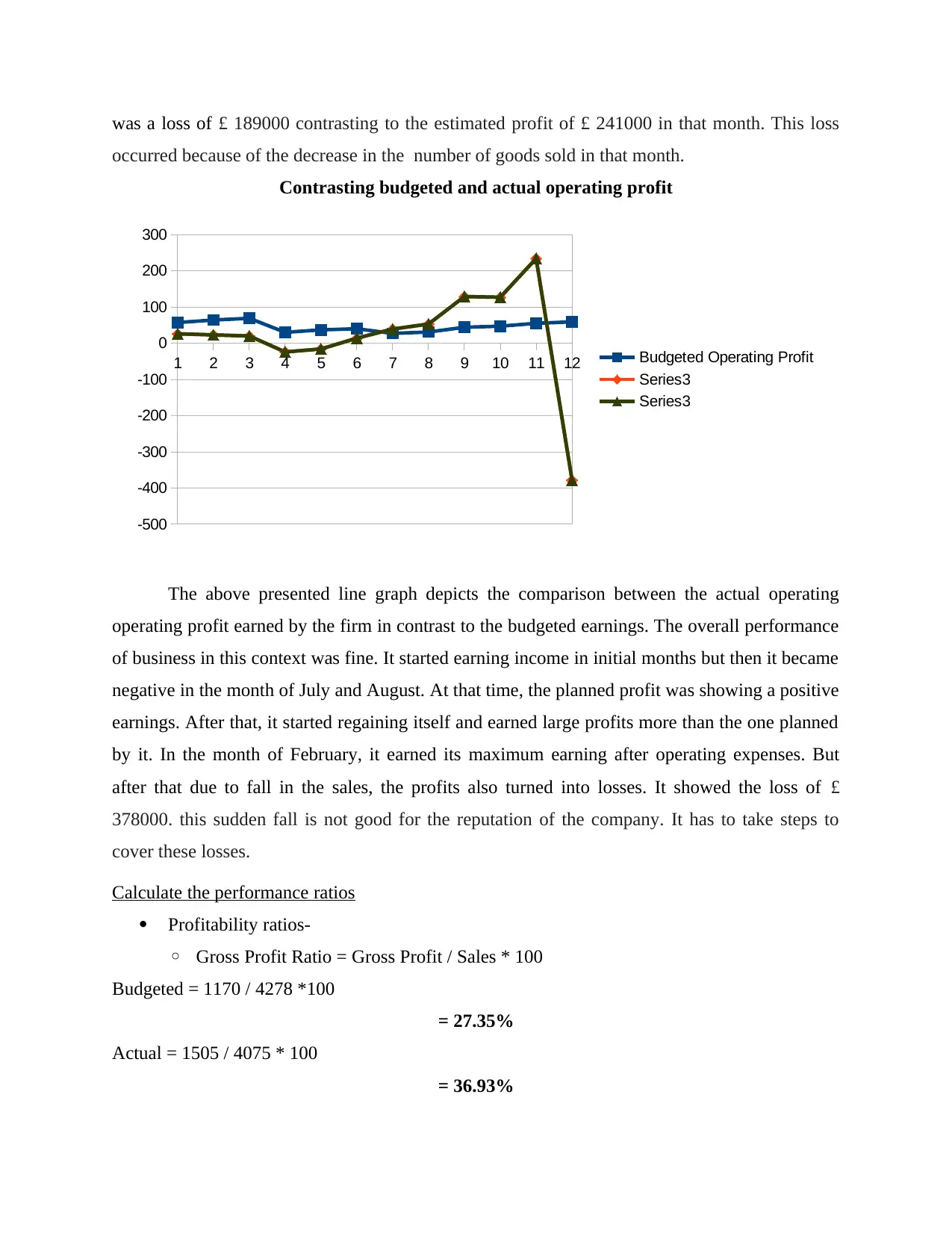
was a loss of £ 189000 contrasting to the estimated profit of £ 241000 in that month. This loss
occurred because of the decrease in the number of goods sold in that month.
Contrasting budgeted and actual operating profit
The above presented line graph depicts the comparison between the actual operating
operating profit earned by the firm in contrast to the budgeted earnings. The overall performance
of business in this context was fine. It started earning income in initial months but then it became
negative in the month of July and August. At that time, the planned profit was showing a positive
earnings. After that, it started regaining itself and earned large profits more than the one planned
by it. In the month of February, it earned its maximum earning after operating expenses. But
after that due to fall in the sales, the profits also turned into losses. It showed the loss of £
378000. this sudden fall is not good for the reputation of the company. It has to take steps to
cover these losses.
Calculate the performance ratios
Profitability ratios-
◦ Gross Profit Ratio = Gross Profit / Sales * 100
Budgeted = 1170 / 4278 *100
= 27.35%
Actual = 1505 / 4075 * 100
= 36.93%
1 2 3 4 5 6 7 8 9 10 11 12
-500
-400
-300
-200
-100
0
100
200
300
Budgeted Operating Profit
Series3
Series3
occurred because of the decrease in the number of goods sold in that month.
Contrasting budgeted and actual operating profit
The above presented line graph depicts the comparison between the actual operating
operating profit earned by the firm in contrast to the budgeted earnings. The overall performance
of business in this context was fine. It started earning income in initial months but then it became
negative in the month of July and August. At that time, the planned profit was showing a positive
earnings. After that, it started regaining itself and earned large profits more than the one planned
by it. In the month of February, it earned its maximum earning after operating expenses. But
after that due to fall in the sales, the profits also turned into losses. It showed the loss of £
378000. this sudden fall is not good for the reputation of the company. It has to take steps to
cover these losses.
Calculate the performance ratios
Profitability ratios-
◦ Gross Profit Ratio = Gross Profit / Sales * 100
Budgeted = 1170 / 4278 *100
= 27.35%
Actual = 1505 / 4075 * 100
= 36.93%
1 2 3 4 5 6 7 8 9 10 11 12
-500
-400
-300
-200
-100
0
100
200
300
Budgeted Operating Profit
Series3
Series3
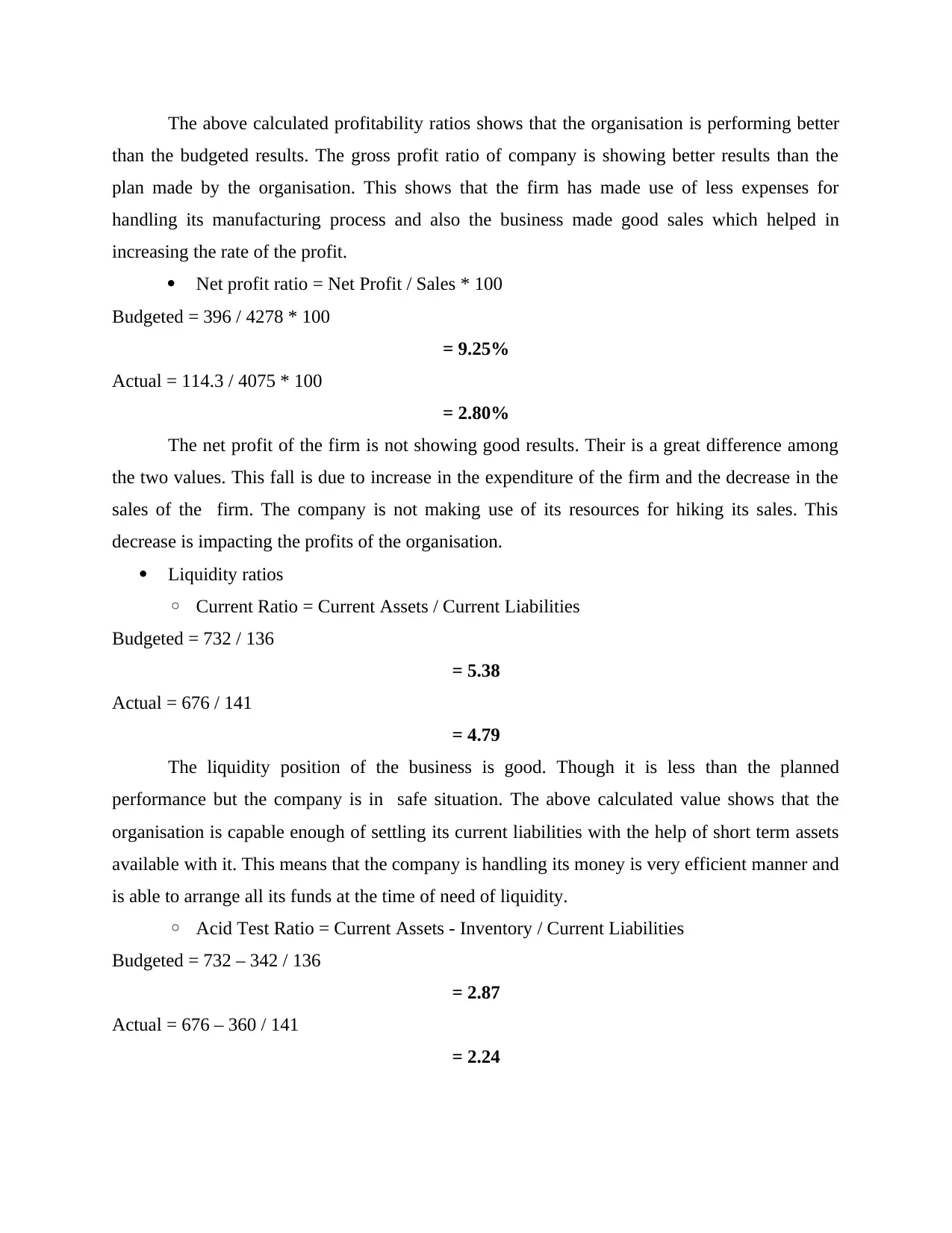
The above calculated profitability ratios shows that the organisation is performing better
than the budgeted results. The gross profit ratio of company is showing better results than the
plan made by the organisation. This shows that the firm has made use of less expenses for
handling its manufacturing process and also the business made good sales which helped in
increasing the rate of the profit.
Net profit ratio = Net Profit / Sales * 100
Budgeted = 396 / 4278 * 100
= 9.25%
Actual = 114.3 / 4075 * 100
= 2.80%
The net profit of the firm is not showing good results. Their is a great difference among
the two values. This fall is due to increase in the expenditure of the firm and the decrease in the
sales of the firm. The company is not making use of its resources for hiking its sales. This
decrease is impacting the profits of the organisation.
Liquidity ratios
◦ Current Ratio = Current Assets / Current Liabilities
Budgeted = 732 / 136
= 5.38
Actual = 676 / 141
= 4.79
The liquidity position of the business is good. Though it is less than the planned
performance but the company is in safe situation. The above calculated value shows that the
organisation is capable enough of settling its current liabilities with the help of short term assets
available with it. This means that the company is handling its money is very efficient manner and
is able to arrange all its funds at the time of need of liquidity.
◦ Acid Test Ratio = Current Assets - Inventory / Current Liabilities
Budgeted = 732 – 342 / 136
= 2.87
Actual = 676 – 360 / 141
= 2.24
than the budgeted results. The gross profit ratio of company is showing better results than the
plan made by the organisation. This shows that the firm has made use of less expenses for
handling its manufacturing process and also the business made good sales which helped in
increasing the rate of the profit.
Net profit ratio = Net Profit / Sales * 100
Budgeted = 396 / 4278 * 100
= 9.25%
Actual = 114.3 / 4075 * 100
= 2.80%
The net profit of the firm is not showing good results. Their is a great difference among
the two values. This fall is due to increase in the expenditure of the firm and the decrease in the
sales of the firm. The company is not making use of its resources for hiking its sales. This
decrease is impacting the profits of the organisation.
Liquidity ratios
◦ Current Ratio = Current Assets / Current Liabilities
Budgeted = 732 / 136
= 5.38
Actual = 676 / 141
= 4.79
The liquidity position of the business is good. Though it is less than the planned
performance but the company is in safe situation. The above calculated value shows that the
organisation is capable enough of settling its current liabilities with the help of short term assets
available with it. This means that the company is handling its money is very efficient manner and
is able to arrange all its funds at the time of need of liquidity.
◦ Acid Test Ratio = Current Assets - Inventory / Current Liabilities
Budgeted = 732 – 342 / 136
= 2.87
Actual = 676 – 360 / 141
= 2.24
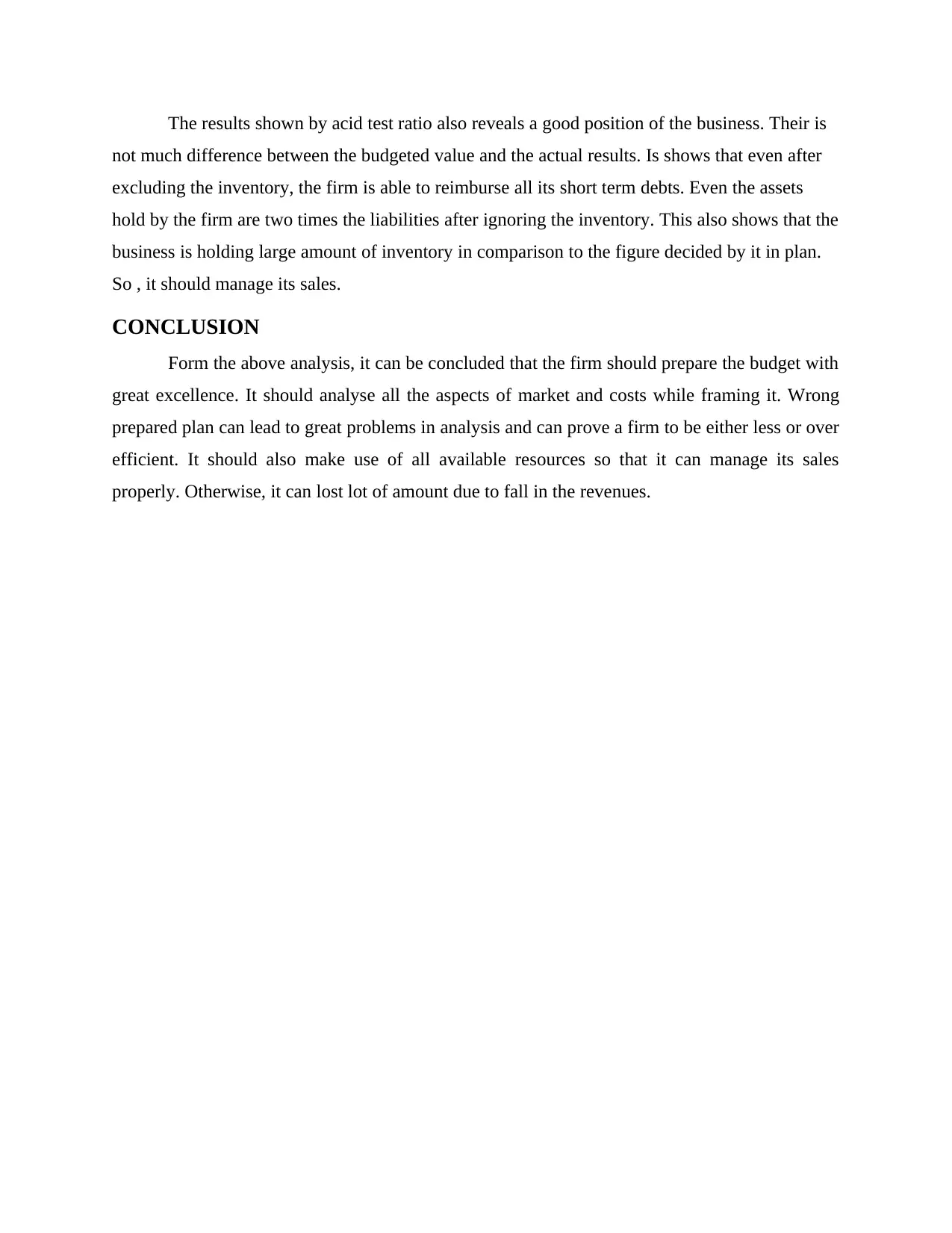
The results shown by acid test ratio also reveals a good position of the business. Their is
not much difference between the budgeted value and the actual results. Is shows that even after
excluding the inventory, the firm is able to reimburse all its short term debts. Even the assets
hold by the firm are two times the liabilities after ignoring the inventory. This also shows that the
business is holding large amount of inventory in comparison to the figure decided by it in plan.
So , it should manage its sales.
CONCLUSION
Form the above analysis, it can be concluded that the firm should prepare the budget with
great excellence. It should analyse all the aspects of market and costs while framing it. Wrong
prepared plan can lead to great problems in analysis and can prove a firm to be either less or over
efficient. It should also make use of all available resources so that it can manage its sales
properly. Otherwise, it can lost lot of amount due to fall in the revenues.
not much difference between the budgeted value and the actual results. Is shows that even after
excluding the inventory, the firm is able to reimburse all its short term debts. Even the assets
hold by the firm are two times the liabilities after ignoring the inventory. This also shows that the
business is holding large amount of inventory in comparison to the figure decided by it in plan.
So , it should manage its sales.
CONCLUSION
Form the above analysis, it can be concluded that the firm should prepare the budget with
great excellence. It should analyse all the aspects of market and costs while framing it. Wrong
prepared plan can lead to great problems in analysis and can prove a firm to be either less or over
efficient. It should also make use of all available resources so that it can manage its sales
properly. Otherwise, it can lost lot of amount due to fall in the revenues.
Secure Best Marks with AI Grader
Need help grading? Try our AI Grader for instant feedback on your assignments.
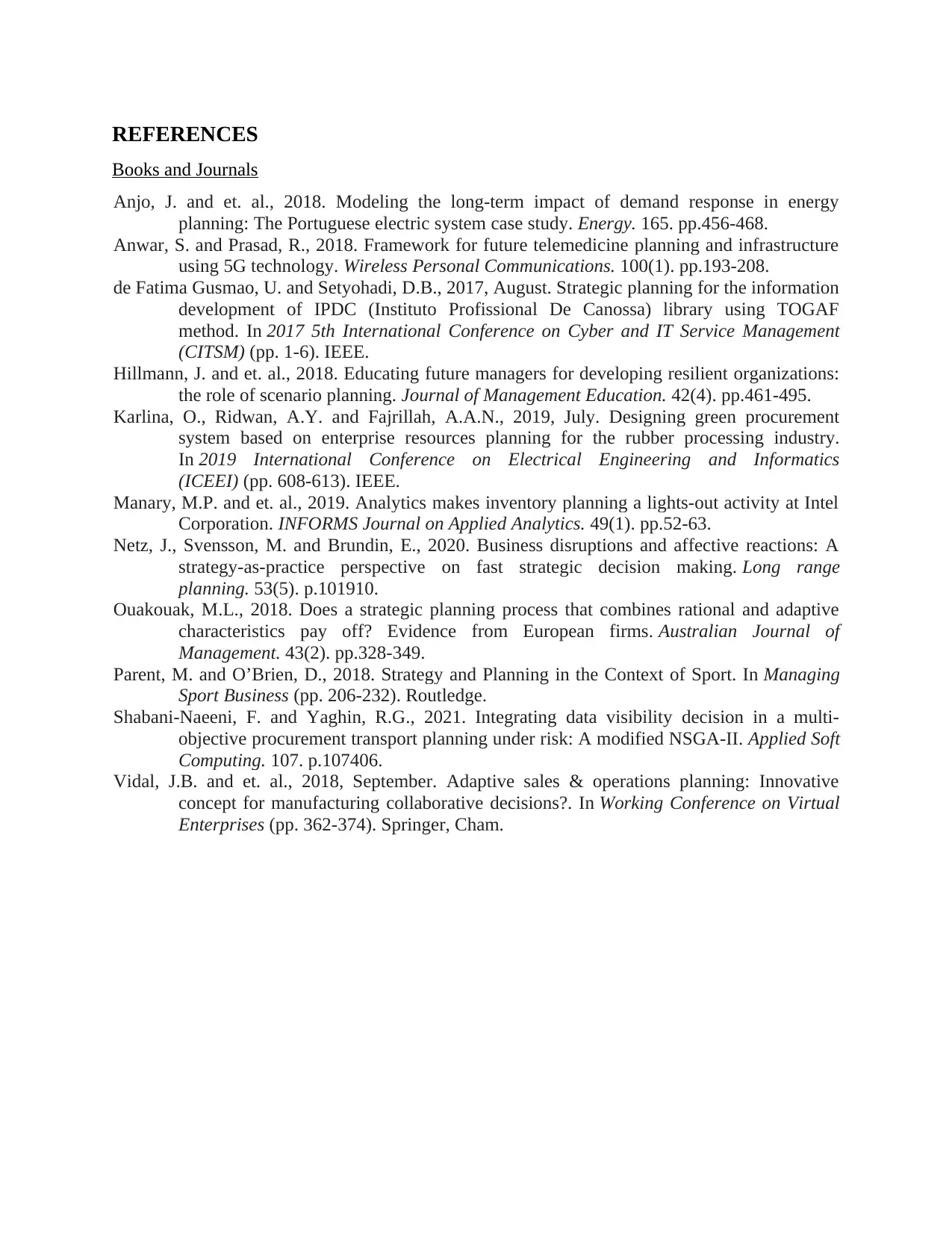
REFERENCES
Books and Journals
Anjo, J. and et. al., 2018. Modeling the long-term impact of demand response in energy
planning: The Portuguese electric system case study. Energy. 165. pp.456-468.
Anwar, S. and Prasad, R., 2018. Framework for future telemedicine planning and infrastructure
using 5G technology. Wireless Personal Communications. 100(1). pp.193-208.
de Fatima Gusmao, U. and Setyohadi, D.B., 2017, August. Strategic planning for the information
development of IPDC (Instituto Profissional De Canossa) library using TOGAF
method. In 2017 5th International Conference on Cyber and IT Service Management
(CITSM) (pp. 1-6). IEEE.
Hillmann, J. and et. al., 2018. Educating future managers for developing resilient organizations:
the role of scenario planning. Journal of Management Education. 42(4). pp.461-495.
Karlina, O., Ridwan, A.Y. and Fajrillah, A.A.N., 2019, July. Designing green procurement
system based on enterprise resources planning for the rubber processing industry.
In 2019 International Conference on Electrical Engineering and Informatics
(ICEEI) (pp. 608-613). IEEE.
Manary, M.P. and et. al., 2019. Analytics makes inventory planning a lights-out activity at Intel
Corporation. INFORMS Journal on Applied Analytics. 49(1). pp.52-63.
Netz, J., Svensson, M. and Brundin, E., 2020. Business disruptions and affective reactions: A
strategy-as-practice perspective on fast strategic decision making. Long range
planning. 53(5). p.101910.
Ouakouak, M.L., 2018. Does a strategic planning process that combines rational and adaptive
characteristics pay off? Evidence from European firms. Australian Journal of
Management. 43(2). pp.328-349.
Parent, M. and O’Brien, D., 2018. Strategy and Planning in the Context of Sport. In Managing
Sport Business (pp. 206-232). Routledge.
Shabani-Naeeni, F. and Yaghin, R.G., 2021. Integrating data visibility decision in a multi-
objective procurement transport planning under risk: A modified NSGA-II. Applied Soft
Computing. 107. p.107406.
Vidal, J.B. and et. al., 2018, September. Adaptive sales & operations planning: Innovative
concept for manufacturing collaborative decisions?. In Working Conference on Virtual
Enterprises (pp. 362-374). Springer, Cham.
Books and Journals
Anjo, J. and et. al., 2018. Modeling the long-term impact of demand response in energy
planning: The Portuguese electric system case study. Energy. 165. pp.456-468.
Anwar, S. and Prasad, R., 2018. Framework for future telemedicine planning and infrastructure
using 5G technology. Wireless Personal Communications. 100(1). pp.193-208.
de Fatima Gusmao, U. and Setyohadi, D.B., 2017, August. Strategic planning for the information
development of IPDC (Instituto Profissional De Canossa) library using TOGAF
method. In 2017 5th International Conference on Cyber and IT Service Management
(CITSM) (pp. 1-6). IEEE.
Hillmann, J. and et. al., 2018. Educating future managers for developing resilient organizations:
the role of scenario planning. Journal of Management Education. 42(4). pp.461-495.
Karlina, O., Ridwan, A.Y. and Fajrillah, A.A.N., 2019, July. Designing green procurement
system based on enterprise resources planning for the rubber processing industry.
In 2019 International Conference on Electrical Engineering and Informatics
(ICEEI) (pp. 608-613). IEEE.
Manary, M.P. and et. al., 2019. Analytics makes inventory planning a lights-out activity at Intel
Corporation. INFORMS Journal on Applied Analytics. 49(1). pp.52-63.
Netz, J., Svensson, M. and Brundin, E., 2020. Business disruptions and affective reactions: A
strategy-as-practice perspective on fast strategic decision making. Long range
planning. 53(5). p.101910.
Ouakouak, M.L., 2018. Does a strategic planning process that combines rational and adaptive
characteristics pay off? Evidence from European firms. Australian Journal of
Management. 43(2). pp.328-349.
Parent, M. and O’Brien, D., 2018. Strategy and Planning in the Context of Sport. In Managing
Sport Business (pp. 206-232). Routledge.
Shabani-Naeeni, F. and Yaghin, R.G., 2021. Integrating data visibility decision in a multi-
objective procurement transport planning under risk: A modified NSGA-II. Applied Soft
Computing. 107. p.107406.
Vidal, J.B. and et. al., 2018, September. Adaptive sales & operations planning: Innovative
concept for manufacturing collaborative decisions?. In Working Conference on Virtual
Enterprises (pp. 362-374). Springer, Cham.
1 out of 14
Related Documents
Your All-in-One AI-Powered Toolkit for Academic Success.
+13062052269
info@desklib.com
Available 24*7 on WhatsApp / Email
![[object Object]](/_next/static/media/star-bottom.7253800d.svg)
Unlock your academic potential
© 2024 | Zucol Services PVT LTD | All rights reserved.





